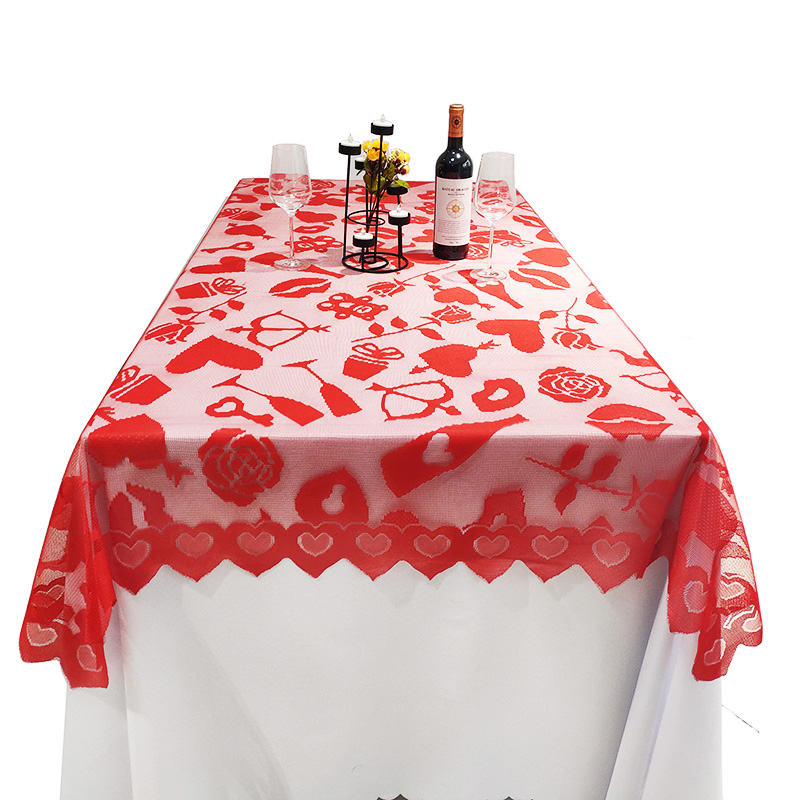How does the Valentine Decoration Love lace tablecloth resist wrinkling and creasing during use?
Posted by Admin
The resistance of a Valentine Decoration Love lace tablecloth to wrinkling and creasing depends largely on the quality of the lace material and its construction. Here are some factors that contribute to its resistance:
Material Quality: The wrinkle resistance of a lace tablecloth is heavily influenced by the quality and type of material used in its construction. High-quality lace fabrics often incorporate durable fibers such as cotton, polyester, or blends of these materials. These fibers are chosen not only for their aesthetic qualities but also for their structural integrity, which contributes to their ability to resist wrinkles. Cotton lace, for example, offers a natural resilience and smooth texture that helps the tablecloth maintain its shape even after repeated use.
Fabric Construction: The construction and weave pattern of the lace fabric play a critical role in its wrinkle resistance. Fabrics with tighter weaves and higher thread counts tend to be more resistant to wrinkles because the fibers are closely packed together, creating a smoother and more stable surface. This structural integrity helps the fabric maintain its appearance and reduces the likelihood of creases forming during handling or use. The density of the weave can affect how well the fabric drapes over a table, enhancing its overall smoothness and minimizing potential wrinkles.
Finishing Treatments: Many lace tablecloths undergo specialized finishing treatments during manufacturing to enhance their wrinkle resistance and overall durability. These treatments may include applying chemical finishes or coatings that create a protective barrier on the fabric's surface. These coatings not only help to smooth out the fabric but also provide additional benefits such as stain resistance or ease of cleaning. Some manufacturers may also utilize mechanical processes like calendaring or pressing to further enhance the fabric's smooth appearance and reduce the tendency to crease.
Care and Handling: Proper care and handling are essential for maintaining the wrinkle-free appearance of a lace tablecloth. This often involves gentle washing with mild detergents, using cold or lukewarm water to prevent shrinking or weakening of the fibers. Avoiding harsh chemicals or bleach that can damage delicate lace fibers is crucial. When drying, it is recommended to air dry or use a low-heat setting on a tumble dryer to prevent excessive shrinkage or distortion of the fabric. Careful handling during washing and drying helps to preserve the fabric's smooth texture and minimize the formation of wrinkles.
Use on Flat Surfaces: Ensuring that the lace tablecloth is placed on a flat and even surface during use can significantly reduce the likelihood of wrinkles and creases. Uneven surfaces or rough textures underneath the tablecloth can cause the fabric to bunch up or fold irregularly, leading to unsightly creases. Using a smooth underlay or table padding beneath the tablecloth provides additional support and helps maintain the fabric's smooth appearance.
Storage: Proper storage practices play a crucial role in preventing wrinkles and preserving the overall quality of the lace tablecloth. When not in use, the tablecloth should be folded neatly along its natural creases or rolled with care to avoid creating deep folds that can result in persistent wrinkles. Storing the tablecloth in a cool, dry place away from direct sunlight and humidity helps to prevent the fabric from becoming stiff or distorted over time. It is also advisable to avoid storing the tablecloth in plastic bags or containers that can trap moisture and promote mildew growth, which can weaken the fabric and cause wrinkles.
Valentine square tablecloth for festival decoration



 English
English Español
Español













